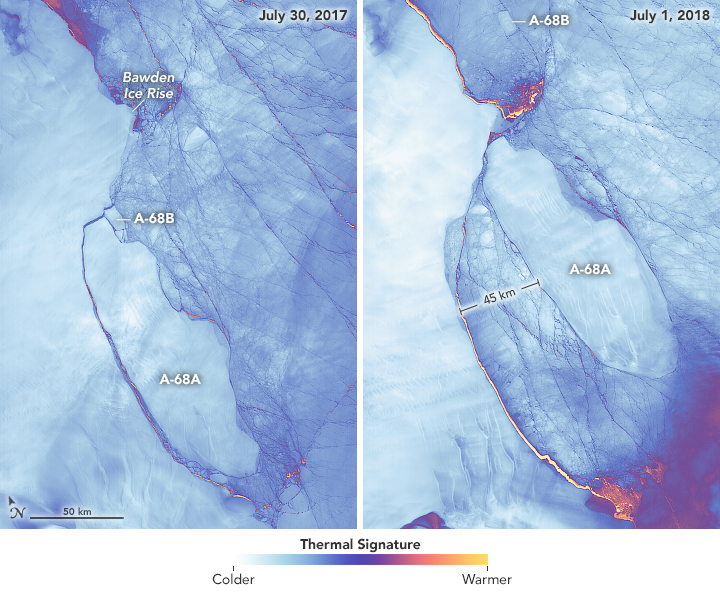Delaware-Size Iceberg Stuck Near Home, Satellite Images Show

An enormous iceberg that split off the Larsen C ice shelf in Antarctica a year ago hasn't gone very far, as a new comparison of satellite images released by NASA shows.
In fact, the iceberg has traveled just 30 miles (47 kilometers) since its birth, which took place sometime between July 10 and July 12, 2017. Officially called Iceberg A-68A, it became one of the largest icebergs on record, and its size was widely compared to Delaware.
Scientists estimated that the iceberg weighs about a trillion tons, and that's part of why the iceberg hasn't gotten very far, all told. It has also gotten stuck in shallow water a couple times and gets waylaid by smaller chunks of sea ice that fill the ocean around Antarctica.
But the iceberg has moved farther than the before-and-after pictures alone would suggest. "Throughout the year, tide cycles have shuffled the berg back and forth like a driver trying to get out of a tight parallel-parking spot," NASA's statement notes.
The comparison images come from the Landsat 8 satellite, which has been in orbit and at work studying changes on Earth's surface since 2013. The satellite carries a thermal camera that gathers data about land-use changes by measuring the temperature of Earth's surface — like the temperature difference between an iceberg and the ocean water surrounding it.
In the images, yellow represents the warmest areas and white the coolest areas, with dark blue and purple areas at medium temperatures. The ocean water surrounding the iceberg appears as a thin line of purple dotted with orange around its white bulk.
But just because the iceberg has stayed close to home so far doesn't mean it will remain there — it just needs the right conditions to break free. When it does, Landsat will be overhead, ready to follow its journey.
Get the Space.com Newsletter
Breaking space news, the latest updates on rocket launches, skywatching events and more!
Email Meghan Bartels at mbartels@space.com or follow her @meghanbartels. Follow us @Spacedotcom, Facebook and Google+. Original article on Space.com.
Join our Space Forums to keep talking space on the latest missions, night sky and more! And if you have a news tip, correction or comment, let us know at: community@space.com.

Meghan is a senior writer at Space.com and has more than five years' experience as a science journalist based in New York City. She joined Space.com in July 2018, with previous writing published in outlets including Newsweek and Audubon. Meghan earned an MA in science journalism from New York University and a BA in classics from Georgetown University, and in her free time she enjoys reading and visiting museums. Follow her on Twitter at @meghanbartels.









